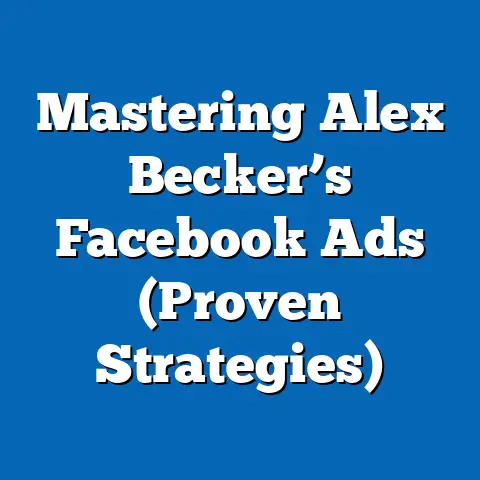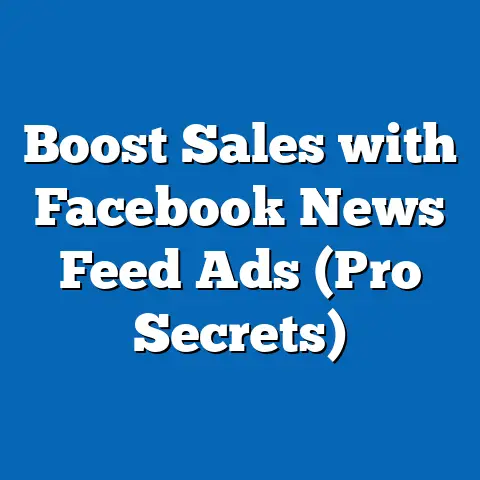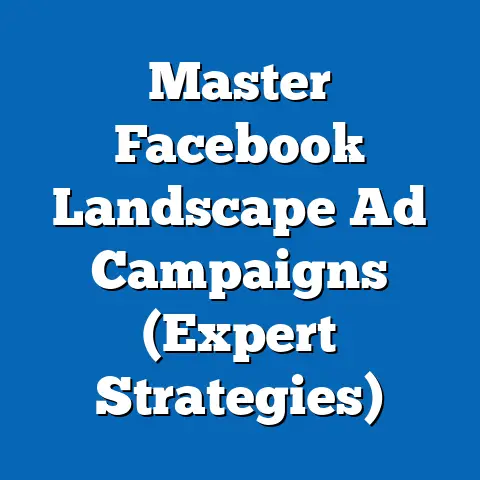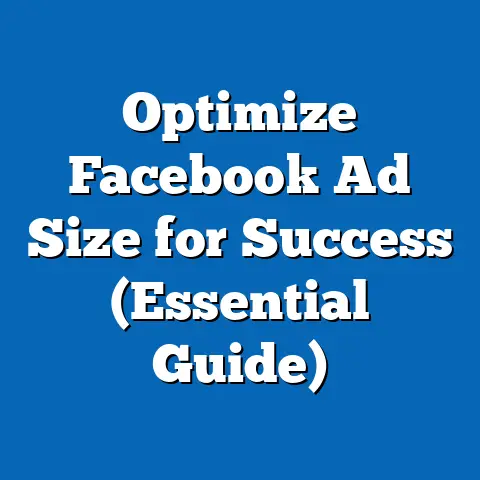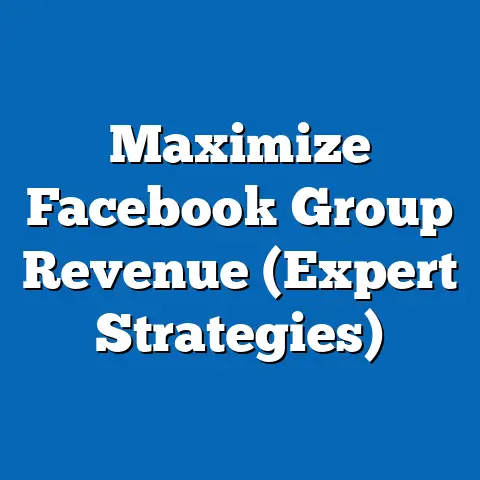Adjusting Facebook Ads End Dates (Strategic Insights)
Adjusting Facebook Ads end dates is a lot like trying to get a toddler to take a nap—just when you think you’ve got it all figured out, something unexpected happens! One minute they’re peacefully drifting off, the next they’re staging a full-blown rebellion against sleep. And just like that toddler, your Facebook ad campaigns can be equally unpredictable.
As someone who’s spent years navigating the ever-changing landscape of digital marketing, I’ve learned that the key to success isn’t just about setting up a great ad; it’s about constantly monitoring, tweaking, and adjusting your strategy based on real-time data. That includes knowing when to pull the plug on a campaign or extend its lifespan to capitalize on unexpected opportunities.
In this article, I’m going to share my insights on the strategic importance of adjusting end dates for your Facebook ads. We’ll explore how this seemingly simple task can impact campaign performance, audience engagement, and overall ROI. So, buckle up, and let’s dive into the world of Facebook ad timing!
The Importance of Timing in Facebook Advertising
Timing is everything, right? It’s a cliché, but it rings particularly true in digital marketing. Think about it: posting a hilarious meme on a Monday morning versus a Friday afternoon can mean the difference between viral fame and crickets. Similarly, the timing of your Facebook ads can significantly impact their performance.
On platforms like Facebook, where ad visibility is constantly fluctuating due to the algorithm’s whims and the sheer volume of content being shared, timing becomes even more crucial. According to recent data, ad engagement rates can vary by as much as 30% depending on the time of day and day of the week. That’s a massive swing!
I remember once running a campaign for a local coffee shop. We had a fantastic ad creative, a compelling offer, and spot-on targeting. But the results were underwhelming. After digging into the data, I realized that our ads were running primarily during the late afternoon and evening when most people were already home from work. By adjusting the schedule to focus on morning hours, we saw a 40% increase in click-through rates and a significant boost in in-store traffic.
Adjusting ad end dates is a strategic tool to maximize effectiveness. It’s not just about setting a date and forgetting about it. It’s about being proactive, data-driven, and responsive to the ever-changing dynamics of your audience and the platform. By carefully monitoring your campaign performance and making timely adjustments, you can ensure that your ads are reaching the right people at the right time, ultimately driving better results.
Key Takeaway: Timing is critical in Facebook advertising. By being mindful of when your ads are running and adjusting end dates accordingly, you can significantly improve their performance.
Reasons to Adjust Ad End Dates
So, why would you want to mess with the end dates of your perfectly crafted Facebook ads? Well, life happens. Market conditions change, your audience’s behavior shifts, and sometimes, your initial assumptions just don’t pan out. Here are some common scenarios that might necessitate adjusting your ad end dates:
- Seasonal Promotions: This is probably the most obvious reason. If you’re running a campaign to promote a holiday sale, a back-to-school event, or any other seasonal promotion, you’ll want to make sure your ads are running during the relevant timeframe. Extending the end date might be necessary if the promotion is extended or if you want to capitalize on last-minute shoppers.
I once worked with a clothing retailer who ran a massive Black Friday sale. They had initially planned to end their Facebook ad campaign on Cyber Monday. However, they noticed that many customers were still browsing their website and engaging with their social media content in the days following Cyber Monday. Based on this data, they decided to extend their ad campaign for another week, resulting in a significant increase in post-holiday sales.
- Changes in Market Conditions: The business world is dynamic, and unexpected events can throw your marketing plans into disarray. A competitor launching a new product, a sudden economic downturn, or even a viral social media trend can all impact the effectiveness of your ads.
I recall a situation where a client of mine, a travel agency, was running a campaign to promote summer vacation packages. However, a major news event caused widespread travel disruptions, leading to a sharp decline in bookings. In response, we paused the campaign, adjusted our messaging to address customer concerns, and then relaunched the campaign with a later end date, focusing on promoting flexible booking options and travel insurance.
- Audience Engagement Metrics: Your ad performance is a treasure trove of information. If your campaign isn’t performing as expected, it might be a sign that you need to adjust your end date. Low click-through rates, high cost-per-click, or a lack of conversions could indicate that your ads are not resonating with your audience.
I had a campaign for a SaaS company that was underperforming. After analyzing the data, I realized that the target audience was engaging with the ads but not converting. It turned out that the free trial period was too short. We extended the trial period and pushed back the ad end date, allowing more users to experience the product’s value before making a purchase decision. This simple change led to a significant increase in conversion rates.
- Real-Time Data: Always keep a close eye on your ad performance.
Real-time data can be your best friend when it comes to making informed decisions about your ad end dates. Facebook’s Ads Manager provides a wealth of information about your campaign performance, including impressions, reach, engagement, and conversions. By monitoring these metrics closely, you can identify trends and patterns that might warrant adjusting your end dates.
Key Takeaway: There are numerous reasons to adjust your ad end dates, from seasonal promotions to changes in market conditions and audience engagement metrics. By being proactive and data-driven, you can ensure that your ads are always running at the optimal time.
Analyzing Performance Metrics
Now that we’ve established why adjusting ad end dates is important, let’s talk about how to determine when to make those adjustments. The key is to analyze your performance metrics. Think of it as reading the tea leaves of your ad campaign. Here are some of the most important KPIs to monitor:
-
Click-Through Rate (CTR): This is the percentage of people who see your ad and click on it. A low CTR could indicate that your ad creative or targeting is not resonating with your audience. If your CTR is consistently low, it might be time to adjust your end date and experiment with different ad creatives or targeting options.
-
Cost Per Click (CPC): This is the amount you pay each time someone clicks on your ad. A high CPC could indicate that your ad is not competitive in the auction or that your targeting is too broad. If your CPC is too high, you might want to adjust your end date and refine your targeting to focus on a more specific audience.
-
Conversion Rate: This is the percentage of people who click on your ad and then take a desired action, such as making a purchase or filling out a form. A low conversion rate could indicate that your landing page is not optimized or that your offer is not compelling. If your conversion rate is low, you might want to adjust your end date and focus on improving your landing page or offer.
Click-Through Rate (CTR): This is the percentage of people who see your ad and click on it. A low CTR could indicate that your ad creative or targeting is not resonating with your audience. If your CTR is consistently low, it might be time to adjust your end date and experiment with different ad creatives or targeting options.
Cost Per Click (CPC): This is the amount you pay each time someone clicks on your ad. A high CPC could indicate that your ad is not competitive in the auction or that your targeting is too broad. If your CPC is too high, you might want to adjust your end date and refine your targeting to focus on a more specific audience.
Conversion Rate: This is the percentage of people who click on your ad and then take a desired action, such as making a purchase or filling out a form. A low conversion rate could indicate that your landing page is not optimized or that your offer is not compelling. If your conversion rate is low, you might want to adjust your end date and focus on improving your landing page or offer.
Facebook’s Ads Manager is your go-to tool for tracking these metrics. It provides a comprehensive overview of your campaign performance, allowing you to drill down into the details and identify areas for improvement. I recommend setting up custom dashboards to track the KPIs that are most important to your business goals.
I remember working with an e-commerce client who was struggling with low conversion rates. After analyzing their data in Ads Manager, I noticed that a significant portion of their website traffic was coming from mobile devices. However, their website was not optimized for mobile, resulting in a poor user experience and low conversion rates. We immediately paused the campaign, optimized the website for mobile, and then relaunched the campaign with a later end date. The result was a dramatic increase in conversion rates and a significant boost in sales.
Key Takeaway: Monitoring your KPIs is essential for determining when to adjust your ad end dates. By using Facebook’s Ads Manager to track metrics like CTR, CPC, and conversion rates, you can identify trends and patterns that might warrant making adjustments.
Best Practices for Adjusting End Dates
Okay, so you know why and when to adjust your ad end dates. Now, let’s talk about how to do it effectively. Here are some best practices to keep in mind:
-
Set Up Reminders: It’s easy to forget about your ad campaigns once they’re up and running. Set up reminders in your calendar to periodically review your ad performance and make any necessary adjustments. I recommend reviewing your campaigns at least once a week, if not more frequently, especially during critical periods like seasonal promotions.
-
Utilize A/B Testing: A/B testing is your secret weapon for optimizing your ad campaigns. Experiment with different ad creatives, targeting options, and end dates to see what works best. For example, you could run two identical ad campaigns with different end dates and see which one performs better.
Set Up Reminders: It’s easy to forget about your ad campaigns once they’re up and running. Set up reminders in your calendar to periodically review your ad performance and make any necessary adjustments. I recommend reviewing your campaigns at least once a week, if not more frequently, especially during critical periods like seasonal promotions.
Utilize A/B Testing: A/B testing is your secret weapon for optimizing your ad campaigns. Experiment with different ad creatives, targeting options, and end dates to see what works best. For example, you could run two identical ad campaigns with different end dates and see which one performs better.
I once ran an A/B test for a client who was promoting a new mobile app. We created two identical ad campaigns, one with an end date of two weeks and the other with an end date of one month. We found that the campaign with the longer end date generated significantly more downloads at a lower cost per download. This was likely because the longer campaign had more time to optimize and reach a wider audience.
- Consider Audience Insights: Your audience is the heart and soul of your ad campaigns. Pay attention to their behavior, preferences, and demographics. Are they engaging with your ads at certain times of the day or on certain days of the week? Are there any demographic trends that might influence your ad performance?
I had a client who was running a campaign to promote a new line of organic baby food. After analyzing their audience insights, I discovered that their target audience was primarily made up of millennial moms who were highly active on social media during the late evening hours. Based on this data, we adjusted the ad schedule to focus on those hours, resulting in a significant increase in engagement and sales.
- Don’t Be Afraid to Experiment: The world of Facebook advertising is constantly evolving, so don’t be afraid to try new things. Experiment with different strategies, tactics, and approaches. The worst that can happen is that something doesn’t work, and you learn something valuable in the process.
Key Takeaway: Adjusting ad end dates is not a one-size-fits-all process. It requires careful planning, ongoing monitoring, and a willingness to experiment. By following these best practices, you can maximize the effectiveness of your ad campaigns and achieve your desired results.
The Role of Audience Insights in Adjustments
Diving deeper into audience insights, it’s crucial to understand that your audience isn’t a static entity. Their needs, behaviors, and preferences evolve over time, and your ad campaigns need to adapt accordingly. This is where audience insights come into play.
Gathering audience feedback is crucial for informing your decisions on end date adjustments. There are several ways to do this:
-
Surveys: Send out surveys to your email list or run polls on your social media channels to get direct feedback from your audience. Ask them about their preferences, pain points, and what they’re looking for from your brand.
-
Social Listening: Monitor your social media channels for mentions of your brand, your competitors, and your industry. Pay attention to what people are saying, what questions they’re asking, and what concerns they’re expressing.
-
Website Analytics: Analyze your website traffic to see how people are interacting with your content. What pages are they visiting? What products are they buying? What keywords are they searching for?
Surveys: Send out surveys to your email list or run polls on your social media channels to get direct feedback from your audience. Ask them about their preferences, pain points, and what they’re looking for from your brand.
Social Listening: Monitor your social media channels for mentions of your brand, your competitors, and your industry. Pay attention to what people are saying, what questions they’re asking, and what concerns they’re expressing.
Website Analytics: Analyze your website traffic to see how people are interacting with your content. What pages are they visiting? What products are they buying? What keywords are they searching for?
I worked with a fitness studio that was running a campaign to promote their new yoga classes. After analyzing their audience feedback, I discovered that many of their customers were interested in learning more about meditation and mindfulness. Based on this insight, we adjusted the ad campaign to promote a new meditation workshop, which proved to be a huge success.
Demographic and psychographic data are also invaluable for making strategic adjustments to your ad campaigns. Demographic data includes information like age, gender, location, and income. Psychographic data includes information like interests, values, and lifestyle.
I once worked with a car dealership that was running a campaign to promote their new line of electric vehicles. After analyzing their demographic data, I discovered that their target audience was primarily made up of affluent, environmentally conscious millennials who lived in urban areas. Based on this data, we adjusted the ad campaign to focus on the environmental benefits of electric vehicles and targeted our ads to specific neighborhoods within the city.
Key Takeaway: Understanding your audience is essential for making informed decisions about your ad end dates. By gathering audience feedback and analyzing demographic and psychographic data, you can ensure that your ads are always relevant and engaging.
Conclusion
Adjusting Facebook ads end dates is more than just a simple task; it’s a strategic decision that can significantly impact your campaign’s success. It’s about being proactive, data-driven, and responsive to the ever-changing dynamics of your audience and the platform.
Remember that toddler I mentioned at the beginning? Well, just like parenting, marketing requires flexibility, patience, and sometimes a bit of luck! But with the right tools, strategies, and a healthy dose of humor, you can navigate the world of Facebook advertising with confidence.
So, embrace the fluidity of digital advertising and view ad adjustments as opportunities for growth and improvement. Keep experimenting, keep learning, and keep pushing the boundaries of what’s possible. And who knows, you might just end up with a Facebook ad campaign that’s as delightful and rewarding as a toddler finally taking a nap!
Now, go forth and conquer the world of Facebook advertising! Your audience awaits.

